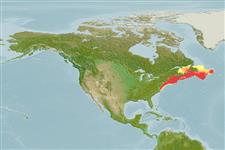Elasmobranchii (sharks and rays) >
Rajiformes (Skates and rays) >
Rajidae (Skates)
Etymology: Dipturus: Greek, di = two + Greek, pteryx = fin (Ref. 45335).
More on author: Mitchill.
Environment: milieu / climate zone / depth range / distribution range
Ecology
Marine; demersal; oceanodromous (Ref. 51243); depth range 0 - 750 m (Ref. 55276), usually 0 - 150 m (Ref. 55276). Temperate; 0°C - 20°C; 51°N - 33°N, 84°W - 42°W (Ref. 55276)
Western Atlantic: Grand Bank and southern Gulf of St. Lawrence in Canada to North Carolina, USA. Threatened with extinction by intensive trawling (Ref. 27438).
Size / Weight / Age
Maturity: Lm ? range ? - ? cm
Max length : 163 cm TL male/unsexed; (Ref. 114953); max. published weight: 18.0 kg (Ref. 7251)
Short description
Identification keys | Morphology | Morphometrics
Disk broad, with sharply angled corners and a pointed snout; front edges concave. No middorsal spines on disk. Tail with 3 rows of spine (1 middorsal row and 1 row on each side). Dorsal fins close together (Ref. 7251). Upper surface brownish, with many scattered small dark spots. Mucous pores on nuchal region. Lower surface white, blotched irregularly with gray (Ref. 6902).
Body shape (shape guide): other.
Occur from water's edge to 430 m depth; absent from shoal waters in south during warm months (Ref. 7251). Found in salinities that range from 35 along the continental edge to 31.5 inshore along the open coast and as low as 21-24 (Ref. 6902). Live on all kinds of bottom (Ref. 205). Benthic (Ref. 5951). Feed on bivalve mollusks, squids, rock crabs, lobsters, shrimps, worms and fishes. Oviparous. Distinct pairing with embrace. Young may tend to follow large objects, such as their mother (Ref. 205). Eggs are oblong capsules with stiff pointed horns at the corners deposited during summer (with 6-month development) in sandy or muddy flats (Ref. 205, Ref. 114953). Egg capsules are 7.1-13.2 cm long and 4.6-7.4 cm wide (Ref. 41250). Males reaches maturity at ca. 100 cm TL, females at 96-105 cm TL; hatch size at 18-19 cm TL (Ref. 114953). Little use is made of the small quantities that are caught. In some cases, they are made into fish meal.
Life cycle and mating behavior
Maturity | Reproduction | Spawning | Eggs | Fecundity | Larvae
Oviparous, paired eggs are laid. Embryos feed solely on yolk (Ref. 50449). Distinct pairing with embrace. Young may tend to follow large objects, such as their mother (Ref. 205).
McEachran, J.D. and K.A. Dunn, 1998. Phylogenetic analysis of skates, a morphologically conservative clade of elasmobranchs (Chondrichthyes: Rajidae). Copeia 1998(2):271-290. (Ref. 27314)
IUCN Red List Status (Ref. 130435: Version 2025-1)
Threat to humans
Harmless
Human uses
Fisheries: of no interest; gamefish: yes
Tools
Special reports
Download XML
Internet sources
Estimates based on models
Preferred temperature (Ref.
123201): 0.9 - 13.9, mean 7.3 °C (based on 497 cells).
Phylogenetic diversity index (Ref.
82804): PD
50 = 0.5000 [Uniqueness, from 0.5 = low to 2.0 = high].
Bayesian length-weight: a=0.00219 (0.00131 - 0.00364), b=3.22 (3.08 - 3.36), in cm total length, based on LWR estimates for this species & Genus-body shape (Ref.
93245).
Trophic level (Ref.
69278): 3.5 ±0.0 se; based on diet studies.
Generation time: 11.0 ( na - na) years. Estimated as median ln(3)/K based on 2
growth studies.
Resilience (Ref.
120179): Low, minimum population doubling time 4.5 - 14 years (Fec assumed to be <100).
Fishing Vulnerability (Ref.
59153): High to very high vulnerability (69 of 100).
🛈
Climate Vulnerability (Ref.
125649): High vulnerability (60 of 100).
🛈
Nutrients (Ref.
124155): Calcium = 4.1 [0.6, 75.0] mg/100g; Iron = 0.259 [0.025, 3.160] mg/100g; Protein = 15.8 [13.7, 17.8] %; Omega3 = 0.68 [0.28, 1.65] g/100g; Selenium = 19 [4, 97] μg/100g; VitaminA = 5.44 [0.42, 65.10] μg/100g; Zinc = 0.287 [0.020, 3.199] mg/100g (wet weight);
